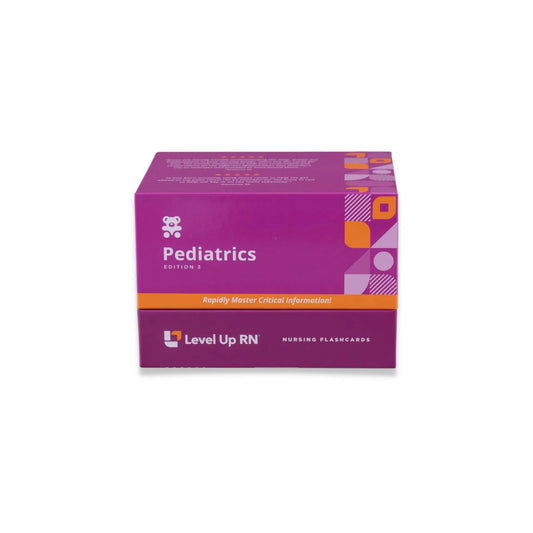Peds, part 34: Nervous Disorders - Head Injury
Updated: Cathy ParkesHead injuries. The pathophysiology of a head injury, including the primary and secondary injury that occurs with a severe head trauma. The risk factors, signs/symptoms, diagnosis, treatment, and nursing care of a patient with a head injury. Finally, key complications associated with a head injury, including: brain herniation, hemorrhage/hematoma, and hydrocephalus.
Full Transcript: Peds, part 34: Nervous Disorders - Head Injury
Full Transcript: Peds, part 34: Nervous Disorders - Head Injury
Hi. I'm Cathy with Level Up RN. In this video, we are going to talk about head injury, and at the end of the video, I'm going to give you guys a little quiz to test your knowledge of some of the key points I'll be covering in this video. So you definitely don't want to miss that. And if you have our Level Up RN pediatric nursing flashcards, definitely pull those out so you can follow along with me.
With a head injury, we have the primary injury that occurs and then a secondary injury that occurs. So during the primary injury, we have acceleration or deceleration forces that result in the injury or destruction of brain tissue. It can also cause a skull fracture or hemorrhaging. But then after that initial injury, we have these reactive processes that happen in the body that further damage the brain tissue. So these reactive processes include an increase in intracranial pressure, cerebral edema, as well as hypoxia.
So risk factors associated with a head injury include falls, sport-related injuries, as well as motor vehicle accidents. It can also include abuse situations such as shaken baby syndrome. Signs and symptoms of a head injury may be mild, or they could be severe. Mild symptoms include headache, confusion, dizziness, blurred vision, as well as lethargy. If we are dealing with a severe head injury, that will cause the signs and symptoms of increased intercranial pressure as well as decreased level of consciousness, pupil abnormalities, retinal hemorrhage, weakness, unsteady gait, and seizures. A CT or MRI can be used to help diagnose a head injury.
If the patient has a concussion, which is a temporary alteration in brain function, this is typically self-resolving in about one to three weeks, and treatment is really focused on rest and a gradual return to activities. If the patient has a severe head injury, then medications such as mannitol or hypertonic saline can be used to rapidly decrease intracranial pressure. Phenobarbital can also be used to induce a coma in the patient and to decrease the metabolic demands of the patient. Opioid analgesics can also be used as well as anticonvulsants. If we are dealing with a severe head injury, mechanical ventilation may be required as well as ICP monitoring, and then the patient may require a craniectomy, which is the removal of nonviable brain tissue.
In terms of nursing care, emergency care is focused on stabilizing the cervical spine while simultaneously maintaining a patent airway. We need to do both of those things simultaneously. Ongoing, we want to monitor the patient's vital signs and their level of consciousness as well as monitor their EKG. In terms of what we need to do to decrease the patient's intracranial pressure, we want to make sure we are hyperventilating the patient and avoiding suctioning whenever possible. In addition, we want to keep the head of the bed at 30 degrees and keep the patient's head midline.
Finally, let's talk about the complications of a head injury. One such complication is brain herniation. This is where we have the downward movement of brain tissue due to cerebral edema, and this can cause symptoms such as fixed dilated pupils, a decrease in level of consciousness, as well as abnormal respirations and posturing. A head injury can also result in hemorrhaging or a hematoma. So we can have an epidural hematoma, which is where we have arterial bleeding between the dura mater and the skull. Or we can have a subdural hematoma. This is where we have venous bleeding between the dura mater and the arachnoid mater. Or we can have intracerebral hemorrhage, which is where we have the accumulation of blood in the brain tissue. Another complication is hydrocephalus. This is where we have an increase in cerebral spinal fluid that causes a buildup of fluid in the brain. And left untreated, this can result in permanent brain damage.
All right. It's time for a quiz. I have three questions for you. First question, what diuretic is used to decrease intracranial pressure in a patient with a severe head injury? The answer is mannitol. Question number two, what is the treatment for a concussion? The answer is rest and a gradual return to activities. So concussions are typically self-resolving. Question number three, fixed dilated pupils and abnormal respiration are signs of what head injury complication? The answer is brain herniation. All right. That's it for this video. I hope you found it helpful. Take care and good luck with studying. Which we talked about in a previous video. So again, that can include.


